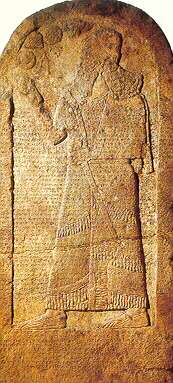Battle of Qarqar
| Battle of Qarqar | |||||||
|---|---|---|---|---|---|---|---|
| Part of the Assyrian conquest of Aram | |||||||
 Kurkh stela of Shalmaneser depicting the battle of Qarqar | |||||||
| |||||||
| Belligerents | |||||||
| Neo-Assyrian Empire |
12 Kings alliance: Kingdom of Hamath Kingdom of Israel Kingdom of Aram-Damascus Egypt (disputed) Kingdom of Ammon Kingdom of Arwad Kingdom of Que Kingdom of Irqanata Kingdom of Shianu Usannata Masura Arabs | ||||||
| Commanders and leaders | |||||||
| Shalmaneser III |
Hadadezer Ahab of Israel Irhuleni of Hamath Gindibu of Arabia Ba'asa of Ammon Kate of Que Matinu Baal of Arwad Adunu Baal of Shianu | ||||||
| Strength | |||||||
|
35,000 army,[1] 20,000 infantry, 12,000 cavalry, 1,200 chariots,[2] |
53,000-63,000 infantry, 4,000 chariots, 2,000 cavalry, 1,000 camelry | ||||||
| Casualties and losses | |||||||
| Unknown | Unknown | ||||||
The Battle of Qarqar (or Ḳarḳar) was fought in 853 BC, when the army of Assyria led by king Shalmaneser III encountered an allied army of eleven kings at Qarqar, led by Hadadezer (also called Adad-idr and possibly to be identified with Benhadad II) of Damascus and King Ahab of Israel. This battle, fought during the 854 BC–846 BC Assyrian Conquest of Syria, is notable for having a larger number of combatants than any previous battle, and for being the first instance in which some peoples enter recorded history (such as the Arabs). The battle is recorded on the Kurkh Monolith. The ancient town of Qarqar at which the battle took place has generally been identified with the modern-day archaeological site of Tell Qarqur near the village of Qarqur.
According to an inscription later erected by Shalmaneser, he had started his annual campaign, leaving Nineveh on the 14th day of Iyar. He crossed both the Tigris and Euphrates without incident, receiving the submission and tribute of several cities along the way, including Aleppo. Once past Aleppo he encountered his first resistance from troops of Irhuleni, king of Hamath, whom he defeated; in retribution, he plundered both the palaces and the cities of Irhuleni's kingdom. Continuing his march after having sacked Qarqar, he encountered the allied forces near the Orontes River.[3]
Twelve Kings
Twelve Kings is an Akkadian term meant to symbolize any kind of alliance. The most famous example is in the Kurkh Monolith, where an alliance of 11 kings are listed as 12 in the Assyrian document as fighting against Assyrian King Shalmaneser III in the battle of Qarqar. Shalmaneser's inscription describes the forces of his opponent Hadadezer in considerable detail as follows:[4]
- King Hadadezer himself commanded 1,200 chariots, 1,200 horsemen and 20,000 soldiers;
- King Irhuleni of Hamath commanded 700 chariots, 700 horsemen and 10,000 soldiers;
- King Ahab of Israel sent 2,000 chariots and 10,000 soldiers;
- The Kingdom of KUR Gu-a-a identified as Que - Cilicia sent 500 soldiers;
- The land of KUR Mu-us-ra- identified as Masura, which is the outlet of the Düden River[5] sent 1,000 soldiers;
- The land of Irqanata (Tell Arqa) sent 10 chariots and 10,000 soldiers;
- King Matinu Baal of Arwad sent 200 soldiers;
- The land of Usannata sent 200 soldiers;
- King Adunu Baal of Shianu - figures lost
- King Gindibu of Arabia sent 1000 camelry;
- King Ba'asa, son of Ruhubi, of the land of Ammon sent 100 soldiers.
Battle
Shalmaneser boasts that his troops inflicted 14,000 casualties upon the allied army, capturing countless chariots and horses, and describes the damage he inflicted on his opponents in savage detail. However, the royal inscriptions from this period are notoriously unreliable. They never directly acknowledge defeats and sometimes claim victories that were actually won by ancestors or predecessors. If Shalmaneser had won a clear victory at Qarqar, it did not immediately lead to further Assyrian conquests in Syria. Assyrian records make it clear that he campaigned in the region several more times in the following decade, engaging Hadadezer six times, who was supported by Irhuleni of Hamath at least twice. Shalmaneser's opponents held on to their thrones after this battle: though Ahab of Israel died shortly afterwards in an unrelated battle, Hadadezer was king of Damascus until at least 841 BC.
External links
References
- ↑ Gabriel A, Richard. "The Great Armies of Antiquity". 1 January 2002. Greenwood Publishing Group,p130. Retrieved 3 February 2015.
- ↑ Gabriel A, Richard. "The Military History of Ancient Israel". 1 January 2003. Greenwood Publishing Group, p48. Retrieved 3 February 2015.
- ↑ "Qarqar and Current Events"Lofquist, L
- ↑ Bunnens, Guy; Hawkins, J.D.; Leirens, I. (2006). Tell Ahmar II. A New Luwian Stele and the Cult of the Storm-God at Til Barsib-Masuwari. Leuven,Belgium: Peeters. pp. 90/1. ISBN 978-90-429-1817-7.
- ↑ Mu-us-ra- is sometimes identified with Egypt, but lay possibly somewhere near Que. Another thesis identifies Mu-us-ra- with Phoenician Sumur, in Syria. (Edward Lipiński, On the Skirts of Canaan in the Iron Age, p.132).
Coordinates: 35°44′34″N 36°19′50″E / 35.742646°N 36.330543°E